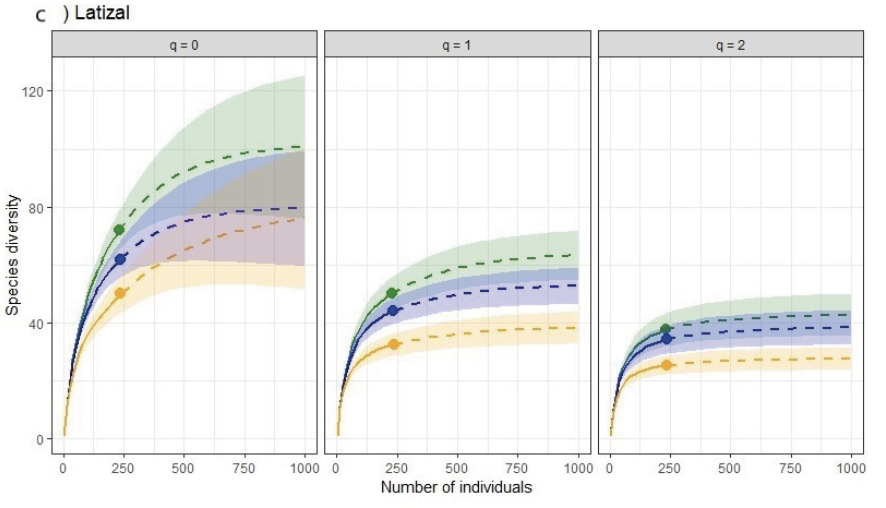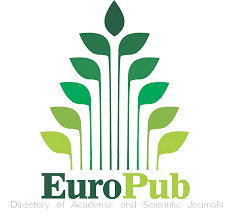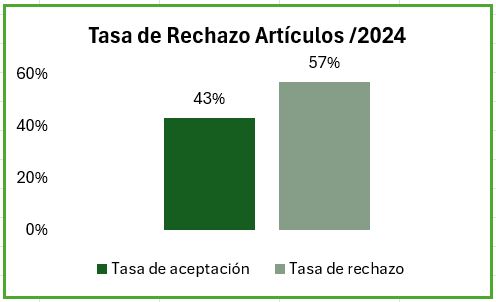Floristic diversity and structure of the natural regeneration of piedmont forest with forest management intervention in southern Ecuador.
DOI:
https://doi.org/10.54753/blc.v14i1.2034Keywords:
seedlings, saplings, sapling, latizal, richness, abundanceAbstract
Natural regeneration is the most important ecological process for forest renewal over time. The present study characterized the floristic composition and population structure of regenerating species with forest management intervention in the piedmont forest of Zamora Chinchipe. Forest areas were stratified according to the time of succession after forest management intervention in five years (T5) and ten years (T10), and a reference area was established where no forest management activities have been implemented (T0). Natural regeneration was evaluated in: seedlings, saplings and saplings. Species rarefaction curves and NDMS multivariate analysis were used for diversity. In addition, structural parameters were generated and the following variables were compared: richness, abundance, diameter at base height (cm) and height (m). The floristic composition of the total natural regeneration (T0; T5; T10) is represented by 125 species, 88 genera and 41 families. Our results showed that there is floristic similarity between seedlings and saplings for T0, T5, T10, with the exception of latizales. The abundance and richness of species showed differences between T0 with respect to T5; T10 in the category of seedlings and saplings. In latizales there were differences in species richness between T10 with respect to T0; T5. The forest management intervention promotes significant changes in the floristic structure and diversity in the strata of natural regeneration of seedlings and latizal.References
Bazzaz, F. A., & Pickett, S. T. A. (1980). Physiological ecology of tropical succession: a comparative review. Annual review of ecology and systematics, 11(1), 287-310.
Bezerra, T. G., Ruschel, A. R., Emmert, F., & Nascimento, R. G. M. (2021). Changes caused by forest logging in structure and floristic diversity of natural regeneration: Relationship between climate variables and forest dynamics in the eastern Amazon. Forest Ecology and Management, 482,118862. https://doi.org/https://doi.org/10.1016/j.foreco.2020.118862.
Britto, P. C., Jaeger, D., Hoffmann, S., Robert, R. C. G., Vibrans, A. C., & Fantini, A. C. (2022). Multi-year, post-harvesting impact assessment in a neotropical secondary Atlantic Forest. European Journal of Forest Research, 141(4), 665-681.
Calva, O; Beltrán, G; Günter, S; Cabrera, O. (2007). Impacto de la luz sobre la regeneración natural de Podocarpáceas en los bosques de San Francisco y Numbala (en línea). Bosques Latitud Cero no. 3: 21–23.
Campo, J., & Vázquez-Yanes, C. (2004). Efectos de la limitación de nutrientes en la dinámica del carbono sobre el suelo durante la regeneración del bosque seco tropical en Yucatán, México. Ecosistemas , 7 , 311-319.
Capa, L. 2014. Efecto de un tratamiento silvicultural sobre el crecimiento de latizales en un bosque tropical de montaña de la estación científica san francisco. Universidad Nacional de Loja, Tesis de Ingeniero Ambiental.
Carey, Y.V., S. Brown, A.J.R. Gillespie y A. Lugo. 1994. Tree mortality in mature lowland tropical moist and tropical lower montane moist forests of Venezuela. Biotropica 26:255-265.
Carreño-Rocabado, G., Peña-Claros, M., Bongers, F., Alarcón, A., Licona, J. C., & Poorter, L. (2012). Effects of disturbance intensity on species and functional diversity in a tropical forest. Journal of Ecology, 100(6), 1453–1463. https://doi.org/10.1111/j.1365- 2745.2012.02015.x
Cerón, C., y Reyes, C. (2003). Predominio de Burseraceae en 1 Ha. de Bosque Colinado, Reserva de Producción Faunística Cuyabeno, Ecuador. Cinchonia, 4(1), 47-60.
Connell, J.H. 1978. Diversity in tropical rain forests and coral reefs. Science 199: 1302-1309.
Clarke, K. R., y Warwick, R. M. (1994). Change in Marine Communities: An Approach to Statistical Analysis and Interpretation. Natural Environment Research. Council. Plymouth. United Kingdom, 144.
Chazdon, R. L., y Uriarte, M. (2016). Natural regeneration in the context of large‐scale forest and landscape restoration in the tropics. Biotropica, 48(6), 709-715.
Ellenberg, D., y Mueller-Dombois, D. (1974). Aims and methods of vegetation ecology (p. 547). New York: Wiley.
Ewel, J. (1980). Tropical succession: manifold routes to maturity. Biotropica, 2-7.
Finegan, B. (1996). Pattern and process in neotropical secondary rain forests: the first 100 years
of succession. Trends in Ecology & Evolution, 11(3), 119–124.
Fournier, L. A., & Herrera, M. E. (1977). La sucesión ecológica como un método eficaz para la recuperación del bosque en Costa Rica. Agronomía Costarricense, 1(1), 23B29.
Gaui, T. D., Costa, F. R. C., de Souza, F. C., Amaral, M. R. M., de Carvalho, D. C., Reis, F. Q., & Higuchi, N. (2019). Long-term effect of selective logging on floristic composition: A 25 year experiment in the Brazilian Amazon. Forest Ecology and Management, 440, 258-266.
Galvez Cusiquispe, P. (2022). Impactos del manejo forestal en la regeneración natural y el contenido de carbono en biomasa aérea Estudio de caso de bosque primario de segunda cosecha y un bosque secundario en Costa Rica. Magister scientiae en Manejo y conservación de bosques tropicales y biodiversidad.
Gerhardt, K. (1993). Tree seedling development in tropical dry abandoned pasture and secondary forest in Costa Rica. Journal of Vegetation Science, 4(1), 95-102.
Gotelli, N. J., y Colwell, R. K. (2001). Quantifying biodiversity: procedures and pitfalls in the measurement and comparison of species richness. Ecology letters, 4(4), 379-391.
Guariguatá, MR y Ostertag, R. (2001). Sucesión del bosque secundario neotropical: cambios en las características estructurales y funcionales. Ecología y gestión forestal , 148 (1-3), 185-206.
Hsieh, T. C., y Ma, K. H. (2016). Chao, A. iNEXT: iNterpolation and EXTrapolation for species diversity. R package version, 2(8), 1-18.
Hooper, DU, Chapin III, FS, Ewel, JJ, Hector, A., Inchausti, P., Lavorel, S., ... & Wardle, DA (2005). Efectos de la biodiversidad en el funcionamiento de los ecosistemas: un consenso del conocimiento actual. Monografías ecológicas , 75 (1), 3-35.
Jadán, O., Cedillo, H., Pillacela, P., Guallpa, D., Gordillo, A., Zea, P., & Vaca, C. (2019). Regeneración de árboles en ecosistemas naturales y plantaciones de Pinus patula (Pinaceae) dentro de un gradiente altitudinal andino (Azuay, Ecuador). Revista de Biología Tropical, 67(1), 182-195.
Jaramillo, L., & Muñoz, L. (2009). Evaluación de la regeneración natural de especies forestales del bosque tropical de montaña en la Estación Científica San Francisco bajo diferentes intensidades de raleo selectivo. Informe de tesis, Universidad Nacional de Lija, Loja. Ecuador.
Janzen, D. H. (1988). Tropical dry forests. Biodiversity, 15, 130-137.
Kalliola, R., Puhakka, M., & Danjoy, W. (1993). Amazonia peruana: vegetación húmeda tropical en el llano subandino.
Khurana, EKTA y Singh, JS (2001). Ecología del crecimiento de semillas y plántulas para la conservación y restauración del bosque seco tropical: una revisión. Conservación ambiental , 28 (1), 39-52.
Larsen, J. G., Duarte, E., Brixner Dreyer, J. B., Pizutti Dallabrida, J., Monteiro Muzeka, L., Neto dos Santos, G., ... & Higuchi, P. (2019). Variación espacio-temporal de la regeneración natural arbórea y arbustiva de bosque de alta montaña en etapa inicial de desarrollo en el sur de Brasil. Bosque (Valdivia), 40(2), 185-193.
Latterini, F., Mederski, P. S., Jaeger, D., Venanzi, R., Tavankar, F., & Picchio, R. (2023). The Influence of Various Silvicultural Treatments and Forest Operations on Tree Species Biodiversity. Current Forestry Reports, 9(2), 59-71.
Lima, AP, Lima, OPD, Magnusson, WE, Higuchi, N. y Reis, FQ (2002). Regeneración de cinco especies de árboles comercialmente valiosas después de la tala experimental en un bosque amazónico. Revista Árvore , 26 , 567-571.
López, C. O. C., Paqui, N. S. C., & Villa, A. F. J. (2021). Análisis multitemporal de la deforestación y cambio de la cobertura del suelo en Zamora Chinchipe. Polo del Conocimiento: Revista científico-profesional, 6(11), 1228-1241.
Lugo, A.E. y F.N. Scatena. 1996. Background and catastrophic tree mortality in tropical moist, wet and rain forests. Biotropica 28:585-599.
Magnusson, W. E.; de Lima, O.P.; Reis, F.Q.; Higuchi, N; Ramos, J.F. 1999. Logging activity and tree regeneration in an Amazonian forest. Forest Ecology and Management, 113: 67-74.
Mariscal, A., Tigabu, M., Savadogo, P., & Odén, P. C. (2022). Regeneration Status and Role of Traditional Ecological Knowledge for Cloud Forest Ecosystem Restoration in Ecuador. Forests, 13(1), 92.
Matteucci, S. D., y Colma, A. (1982). Metodología para el estudio de la vegetación (Vol. 22). Washington, DC: Secretaria General de la Organización de los Estados Americanos.
Ministerio del Ambiente del Ecuador. (2018). Estadísticas del patrimonio natural del Ecuador continental.
Morales-Arias, J. G., Olvera-Vargas, M., Cuevas-Guzmán, R., Figueroa-Rangel, B. L., & Sánchez-Rodríguez, E. V. (2018). Variación ambiental y composición florística de especies arbóreas en un bosque húmedo de montaña del occidente de México. Revista mexicana de biodiversidad, 89(3), 769-783.
Moreno, C. (2001). Métodos para medir la biodiversidad. M&T–Manuales y Tesis SEA. In Zaragoza (Ed.), M&T–Manuales y Tesis SEA (Vol. 1).
Mostacedo, B., y Fredericksen, T. (2000). Manual de métodos básicos de muestreo y análisis en ecología vegetal (Vol. 87). Santa Cruz, Bolivia: Proyecto de Manejo Froestal Sostenible (BOLFOR).
Muñoz, J. (2014). Efectos en la regeneración natural en claros por tratamientos silviculturales en un bosque tropical de montaña del sur del Ecuador (en línea). Revista CEDAMAZ 1 (5): 66-80.
Muñoz Chamba, J. C., y Muñoz, L. (2010). Evaluación de la composición florística de la regeneración natural del bosque tropical de montaña en la Estación Científica San Francisco bajo diferentes intensidades de raleo selectivo.
Naves, RP, Grøtan, V., Prado, PI, Vidal, E., & Batista, JLF (2020). El manejo de los bosques tropicales alteró la abundancia de especies de árboles individuales pero no la diversidad. Ecología y manejo forestal , 475 , 118399.
Norden, N. (2014). Del porqué la regeneración natural es tan importante para la coexistencia de especies en los bosques tropicales. Colombia forestal, 17(2), 247-261. http://dx.doi.org/10.14483/udistrital.jour.colomb.for.2014.2.a08
Pariona, A. W. (2001). Regeneración natural después del aprovechamiento forestal en fajas a tala rasa en un bosque tropical Boliviano. Proyecto de Manejo Forestal Sostenible (BOLFOR). Santa Cruz (Bol), 185-202.
R Core Team. (2019). R: A language and environment for statistical computing. Vienna, Austria: R Foundation for Statistical Computing,. Retrieved from http://www.r-project.org/.
Rozendaal, D. M. A., Bongers, F., Aide, T. M., Alvarez-Dávila, E., Ascarrunz, N., Balvanera, P., Becknell, J. M., Bentos, T. v, Brancalion, P. H. S., Cabral, G. A. L., Calvo-Rodriguez, S., Chave, J., César, R. G., Chazdon, R. L., Condit, R., Dallinga, J. S., de AlmeidaCortez, J. S., de Jong, B., de Oliveira, A., … Poorter, L. (2019). Biodiversity recovery of Neotropical secondary forests. Science Advances, 5(3), eaau3114. https://doi.org/10.1126/sciadv.aau3114
Sáenz, G., Finegan, B., & Guariguata, M. (1999). Crecimiento y mortalidad en juveniles de siete especies arbóreas en un bosque muy húmedo tropical intervenido de Costa Rica. Revista de biología tropical, 47(1-2), 45-57.
Sáenz, G. P., Finegan, B. 2000. Monitoreo de la regeneración natural con fines de manejo forestal. Manejo Forestal Tropical 15: 2
Silveira AP, FR Martins, BS Menezes, FS Araujo. 2017. Is the spatial pattern of a tree population in a seasonally dry tropi¬cal climate explained by density-dependent mortality? Aus¬tral Ecology 43:191-202. DOI: 10.1111/aec.12556
Valencia, R., Balslev, H., & Paz Y Miño C, G. (1994). High tree alpha-diversity in Amazonian Ecuador. Biodiversity & Conservation, 3, 21-28.
Wijdeven, S. M., & Kuzee, M. E. (2000). Seed availability as a limiting factor in forest recovery processes in Costa Rica. Restoration ecology, 8(4), 414-424.
Whitmore, T. C. (1984). Tropical rain forests of the Par East. Clarendon Press, Oxford. DOI, 10, 0143-6228.
Yaguana Puglla, C, A, (2020), Florestas tropicais pluviais montanas do sul do Equador: fatores condicionantes da estrutura, composição e dinâmica.

Published
How to Cite
Issue
Section
License
Copyright (c) 2024 Bosques Latitud Cero

This work is licensed under a Creative Commons Attribution-NonCommercial-ShareAlike 4.0 International License.
This work is published under the Creative Commons Attribution-NonCommercial-ShareAlike 4.0 International (CC BY-NC-SA 4.0) license. This means that users may copy, distribute, and adapt the content, provided that proper credit is given to the authors and the journal. Commercial use of the material is not permitted. Additionally, any derivative work must be distributed under the same license. This license ensures open access to knowledge, promoting the dissemination and reuse of published works for non-commercial purposes, respecting authorship, and ensuring the free circulation of content under fair terms.




























